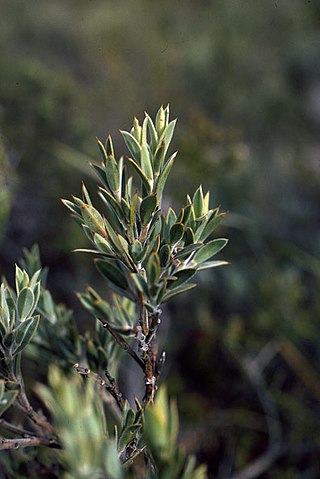
Gastrolobium melanopetalum is a shrub in the family Fabaceae which is endemic to the south-west of Western Australia.

Lasiopetalum maxwellii is a species of flowering plant in the family Malvaceae and is endemic to the south coast Western Australia. It is a sprawling shrub with hairy young stems, lance-shaped to oblong leaves and white to cream-coloured flowers.

Hovea acanthoclada, commonly known as thorny hovea, is a flowering plant in the family Fabaceae. It is an upright, prickly shrub with small dark green leaves and purple-blue pea flowers in winter and spring. It is endemic to the south-west of Western Australia.

Mirbelia oxylobioides, commonly known as mountain mirbelia or sandstone bushpea, is a species of flowering plant in the family Fabaceae and is endemic to south-eastern Australia. It is a low-lying or erect shrub with narrowly elliptic to egg-shaped leaves and orange-yellow and reddish-purple flowers arranged near the end of the branches.

Eremophila willsii is a flowering plant in the figwort family, Scrophulariaceae and is endemic to Australia. It is an erect shrub with bright green, often serrated leaves and pinkish to deep pinkish-purple petals. It is mainly found in Western Australia, the Northern Territory and South Australia in deep sand.

Quoya loxocarpa is a flowering plant in the mint family Lamiaceae and is endemic to Western Australia and the Northern Territory. It is an open shrub with many spindly tangled branches. The leaves are oblong and woolly when young and the flowers are whitish pink with purple spots inside and are surrounded by woolly sepals.

Kunzea opposita is a plant in the myrtle family, Myrtaceae and is endemic to eastern Australia. It is a spindly shrub which has small leaves arranged in opposite pairs, and pink flowers with five petals and many stamens, the stamens much longer than the petals. It usually grows in woodland or on exposed cliffs.

Pultenaea skinneri, commonly known as Skinner's pea, is a species of flowering plant in the family Fabaceae and is endemic to the south-west of Western Australia. It is a slender shrub with simple leaves, and yellow, red and orange flowers with red markings.

Commersonia craurophylla, commonly known as brittle leaved rulingia, is a species of flowering plant in the family Malvaceae and endemic to southern continental Australia. It is a dense, spreading shrub with crinkled, narrowly oblong to linear leaves, and white to cream-coloured flowers.

Hibbertia glaberrima is a species of flowering plant in the family Dilleniaceae and is endemic to Central Australia. It is a glabrous, spreading shrub with oblong to lance-shaped leaves and yellow flowers borne singly in upper leaf axils, with 30 to 150 stamens arranged around three carpels.

Pultenaea hartmannii is a species of flowering plant in the family Fabaceae and is endemic to an area around the border between New South Wales and Queensland. It is an erect shrub with hairy stems, oblong to triangular leaves with the narrower end towards the base, and yellow flowers with red markings.

Pultenaea heterochila is a species of flowering plant in the family Fabaceae and is endemic to the south of Western Australia. It is an erect, low-lying or prostrate shrub with hairy leaves and yellow and red flowers.

Pultenaea involucrata is a species of flowering plant in the family Fabaceae and is endemic to the south-east of South Australia. It is a compact shrub with hairy branches, hairy egg-shaped to lance-shaped leaves, and yellow and red flowers.
Gompholobium gompholobioides is a species of flowering plant in the family Fabaceae and is endemic to the south-west of Western Australia. It is a spreading shrub with pinnate leaves and uniformly yellow, pea-like flowers.

Bossiaea neoanglica is a species of flowering plant in the family Fabaceae and is endemic to eastern Australia. It is a prostrate to low-lying shrub with sparsely hairy foliage, egg-shaped to more or less round leaves, and yellow and red flowers.

Daviesia abnormis is a species of flowering plant in the family Fabaceae and is endemic to the south-west of Western Australia. It is an erect, hairy shrub with sharply-pointed, narrow elliptic to narrow egg-shaped phyllodes with the narrower end towards the base, and yellow flowers with faint red markings.

Daviesia cardiophylla is a species of flowering plant in the family Fabaceae and is endemic to the southwest of Western Australia. It is an erect, spreading shrub with heart-shaped, sharply pointed phyllodes and yellow and red flowers.

Olearia exiguifolia commonly known as small-leaved daisy bush, is a species of flowering plant in the family Asteraceae and is endemic to south-western Australia. It is an erect or straggly shrub with broadly egg-shaped leaves with the narrower end towards the base, and white and yellow, daisy-like inflorescences.

Spyridium waterhousei is a species of flowering plant in the family Rhamnaceae and is endemic to Kangaroo Island in South Australia. It is an erect, slightly sticky shrub with linear leaves and heads of hairy flowers with three brown bracts at the base.

Commersonia magniflora is a species of flowering plant in the family Malvaceae and endemic to Australia. It is an erect shrub with wrinkled, narrowly oblong to elliptic or egg-shaped leaves, and deep pink flowers.



















